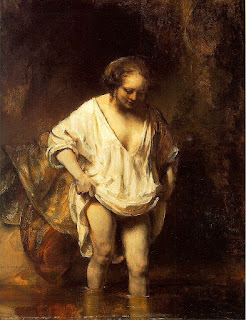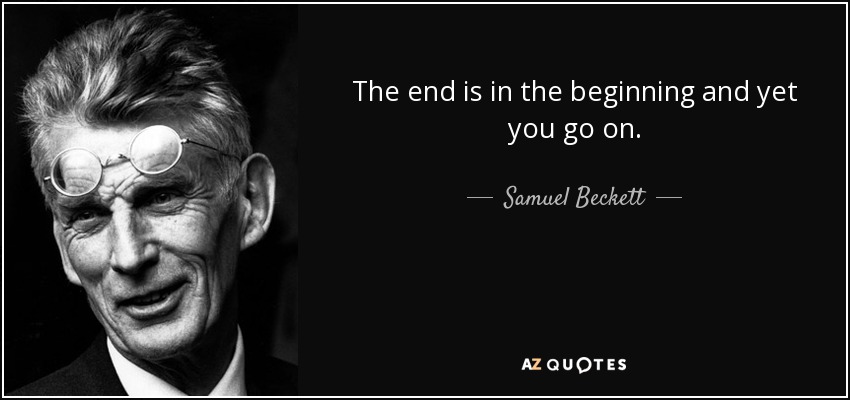On Beauty and Being Wrong (Part III)
“Ah-a Hopper,” said Kiki, pleased at the coincidence. It was a print of Road in Maine, one of the series of poorly reproduced lithographs of famous American paintings meant to signal the classiness of the store ...”Someone's just walked down there,” she murmured, her finger travelling softly along the flat, paintless surface. “Actually, I think it was me. I was moseying along counting posts. With no idea where I was going. No family. No responsibilities. Wouldn't that be fine! “Let's go to Amherst,” said Carlene Kipps urgently.(“On Beauty” (end of section 2, “The Anatomy Lesson,” page 268)
The bond between the two ladies, Carlene and Belsey, has by now narrowed in their sparse encounters, and , consolidated through an inarticulated reality of common understanding and unison. This intrinisic reality (equally attributed to this Hopper's landscape) surpasses the ideological confrontation of their respective partners for the sake of beauty, embodied in their joint admiration for the “The Maitresse Erzulie” painting which Carlene shrines in her house; an undermining of academic verbal pyrotechnics and the prospect of embarking themselves on this Amherst adventure with “no responsibilities”. However, the likelihood of this occurrence is curtailed by the uneventful apperance of Carlene's son, Michael, and husband, Mr Kipps. Amherst, Emily Dickinson's hometown and burial place, constitutes one of the many strewn references to Emily Dickinson in this novel.
“I Died for Beauty,” written by Emily Dickinson acquires utmost relevance at this crux between section 2 and section 3:
I died for beauty, but was
scarce
Adjusted in the tomb,
When one who died for truth was
lain
In an adjoining room.
He questioned softly why I failed?
"For beauty," I replied.
"And I for truth -
the two are one;
We brethren are," he said.
And so, as
kinsmen met a-night,
We talked between the rooms,
Until the
moss had reached our lips,
And covered up our names.
“On Beauty and Being wrong” opens up with Carlene's death, burial, wake and legacy to Kiki, the painting by Hector Hyppolite, “The Maitresse Erzulie.” The Kippses reluctance to grant Kiki the painting and its concealment set the “deus ex machina” of the narrative in motion. Levi will set the balance right by returning the painting to its origins through his own political activist crusade with the Haitians.
“On Beauty and Being Wrong” also lingers on Howard's struggle with his own insecurities, his middle-aged crisis, his being wrong and wanting to be right, his infidelities, his re-reading of Rembrandt, his re-reading of love, his dissension with academia, his misinterpretations and misencounters. He travels back through the stranded road of time to encounter his father, the butcher, who wanted him to write about beautiful things that may have enlightened his mother, the woman they both loved and the only thing in common. He storms out to discover that time has congealed misunderstanding.
Carl, the street poet, the lyricist, ascends the podium of academia. He is allotted a nook in the library archive, in the Department of Black studies, but the system stifles him. He banishes from the narrative after a misalignment of stars. Victoria´s overpowering beauty snowballs disaster: the unfortunate matches-- Howard and Victoria, Carl and Victoria, Victoria and Zora, Victoria and Jerome-- ensue chaos. Monty is equally unmasked and exposed in a faux pas of not communing with his preaching.
The novel ends with Howard's contemplation of this painting:
“Hendrickje Bathing, 1654,’ croaked Howard and said no more... The woman’s fleshiness filled the wall. He looked out into the audience once more and saw Kiki only. He smiled at her. She smiled. She looked away, but she smiled. Howard looked back at the woman on the wall, Rembrandt’s love, Hendrickje. Though her hands were imprecise blurs, paint heaped on paint and roiled with the brush, the rest of her skin had been expertly rendered in all its variety – chalky whites and lively pinks, the underlying blue of her veins and the ever present human hint of yellow, intimation of what is to come.”
Go ahead and post your comments on the gnarling of this section!






Eventually Howard fails again when he tries to show part of his work using a slideshow but this new failure makes him more human: he awakes from his world of intellectuality and keeps his feet on the ground again. He acknowledges his mistake and perhaps all the mistakes of his past life and a warm smile and a friendly gaze of Kiki become the most private moment they share together since long time ago, a moment of mutual understanding and intimacy, probably the same intimacy masterfully depicted by Rembrandt in “A Woman Bathing in a Stream”
ReplyDeletep.s.
Probably my interpretation of a “last-minute-saved-marriage” is not entirely accurate ..but even Zadie Smith does not know the end of the story “(..) I have absolutely no idea where their marriage is headed. The book ends for me exactly where it ends for you. I have no imagination outside of my books.” ( https://www.penguinrandomhouse.com/books/294826/on-beauty-by-zadie-smith/9780143037743/readers-guide/ )
Btw
What an incredible source of knowledge and entertaining for Art Lovers!
Visit https://www.nationalgallery.org.uk/paintings/rembrandt-a-woman-bathing-in-a-stream-hendrickje-stoffels#VideoPlayer100828
In this part III, we learn a bit about Howard’s teenage years. In particular, we learn about his philosophy of life: “The unexamined life is not worth living. That had been Howard’s callow teenage dictum. Nobody tells you, at seventeen, that examining it will be half the trouble.” Actually, “The unexamined life is not worth living” is a famous quote by the Greek philosopher Socrates, who was a very important percusor of Stoicism. Unlike other philosophical movements, Stoicism is a practical philosophy that teaches us how to live a good life, even when faced with difficult life circumstances. Stoics pursue self-improvement through four virtues: wisdom, courage, justice and temperance. In the book, I think many of Howard’s attitudes diverge from these ideal virtues. For example: he is very self-centred, he lies to Kiki when she confronts him about his affair, he is not able to resist his desires to be with other women, he is very critical of people whose opinions differ from his… However, towards the end of the book we start seeing some changes in Howard. For example: he seems indifferent that his presentation is a failure as he smiles to Kiki, he stops his affair with Victoria before being caught, he starts to value more his kids and his wife, he makes no comments when Jerome says that he’s going to the church, he stops smoking… At the end of the book, I felt hopeful for Howard. Despite the fact that he his going through a difficult moment right now, i.e. forced sabbatical, divorce, and tight finances, I think that he is finally doing the “other half”.
ReplyDeleteFor more on Stoicism I recommend the short Ted Ed video: https://youtu.be/R9OCA6UFE-0 and the books: “A guide to the good life” by William Irvine or “Stoicism and the art of happiness” by Donald Robertson.
How beautiful Emily Dickinson's poem is! Beauty is Truth. Truth Beauty. The Great Romantic Keats and Poe also shared the same ideal. That is the essence of Poetry and Art in general.
ReplyDeleteIn this third part, We are presented with 2 types of Beauty(that I can see��). On the one hand, Victoria represents the external beauty which causes disaster. By contrast, Dickinson poetry is sublime. You read it and it captures your heart and soul ♥️. It's curious that Carlene chooses this poem for her funeral.
As you know, my beloved Emily lived in a puritan society. Even her family had strong religious beliefs. It was in her poetry where she found true meaning... ��I wonder if Carlene changed her strong morals for Emily's poetry! �� Maybe.
Our beloved Emily composed her poems in confinement It was a personal decision, though. That is what Hoppers painting shows as well:isolation, solitude, quietness...
A rose for Emily ��
Merry Christmas everyone����
PD. Thanks to Lavinia. Emily's little sister, who was well aware of her eldest sisters genius, collected her poems and got them published. Just sorority ��